An Environmental–Economic Benefit for Sustainability Assessment of Highly Mineralized Mine Water Reuse
Abstract
1. Introduction
2. Materials and Methods
2.1. Impact Mechanism of HWW Utilization
2.2. Theoretical Foundation and Analysis
2.2.1. Externality Theory
2.2.2. System of Integrated Environmental and Economic Accounting
2.2.3. Green GDP Accounting
2.2.4. Input–Output Method
2.3. Integrated Environmental–Economic Accounting of HMMW Utilization
2.3.1. Refinement of Water Production and Supply Industry
2.3.2. Environmental Benefits Calculation of HMMW Utilization
2.3.3. Integrated Environmental–Economic Accounting
2.4. Study Area
2.4.1. Water Consumption
2.4.2. Water Cost
2.4.3. HMMW Quality
3. Results
3.1. Economic Data Sources and Processing
3.2. Water Production and Supply Industry Split
3.3. Environmental Benefits Accounting
4. Discussion
4.1. Input–Output Balance Verification
4.2. Verification of Environmental Benefits of HMMW Utilization
4.3. Limitations and Considerations for Future Applications
5. Conclusions and Implications
5.1. Conclusions
5.2. Policy and Management Implications
Author Contributions
Funding
Institutional Review Board Statement
Informed Consent Statement
Data Availability Statement
Conflicts of Interest
References
- Chen, E. Global freshwater crisis intensifies. Ecol. Econ. 2022, 38, 4. Available online: https://kns.cnki.net/kcms2/article/abstract?v=IMWkopLkOPXfzbl4RMGpERW8BqfBefKt6A2M6HJIqGmjF-DOq1F3oBqzNBjFaQxJh50Rm9LZNu5nDcuvS2y55fUkgcQBgGg0780CCkjdmHgrJYZCS3WQANTB8k1zQ9DLSXZtE5mhP6zRlJ8pCvuokvZtlgTSxNqH4p_8WSII42bgO4AnLFR-jw==&uniplatform=NZKPT&language=CHS (accessed on 24 September 2025).
- Kranz, K.; Dillenardt, J. Mine Water Utilization for Geothermal Purposes in Freiberg, Germany: Determination of Hydrogeological and Thermophysical Rock Parameters. Mine Water Environ. 2010, 29, 68–76. [Google Scholar]
- Wang, H.; Dong, S.; Shang, H.; Wang, T.; Yang, J.; Zhao, C.; Zhang, Q.; Zhou, Z.; Liu, J.; Hou, Y. Domestic and foreign progress of mine water treatment and resource utilization. Coal Geo. Explor. 2023, 51, 15. [Google Scholar]
- Wang, X.; Zou, Y.; Zhao, R.; Yang, X.; Jia, B.; Huang, Y. Advanced treatment and reuse of highly mineralized mine wastewater. China Water Wastewater 2009, 25, 56–58. [Google Scholar]
- Pang, Z. Research on Water Resources Utilization in Coal Mines’Taking Huainan Mining Area As an Example. Master′s Thesis, Degree-Anhui University of Science and Technology Anhui, Huainan, China, 2005. [Google Scholar]
- Gu, D.; Li, J.; Cao, Z.; Wu, B.; Jiang, B.; Yang, Y.; Yang, J.; Chen, Y. Technology and engineering development strategy of water protection and utilization of coal mine in China. J. China Coal Soc. 2021, 46, 3079–3089. [Google Scholar]
- Gu, D.; Li, T.; Li, J.; Guo, Q.; Jiang, B.; Bian, W.; Bao, Y. Current status and prospects of coal mine water treatment technology in China. Coal Sci. Tech. 2021, 49, 11–18. [Google Scholar]
- Sun, Z. The Ministry of Water Resources further promotes the special rectification action for soil and water conservation in the Yellow River Basin and the “Implementation of the Outline of the Yellow River Basin Ecological Protection and High quality Development Plan”. Soi. Water Con. Chi. 2021, 6, 1. [Google Scholar] [CrossRef]
- Zhang, S.; Wang, H.; He, X.; Guo, S.; Xia, Y.; Zhou, Y.; Liu, K.; Yang, S. Research progress, problems and prospects of mine water treatment technology and resource utilization in China. Crit. Rev. Environ. Sci. Technol. 2019, 50, 1–53. [Google Scholar] [CrossRef]
- Itskos, G.; Koutsianos, A.; Koukouzas, N.; Vasilatos, C. Zeolite development from fly ash and utilization in lignite mine-water treatment. Int. J. Miner. Process. 2015, 139, 43–50. [Google Scholar] [CrossRef]
- Wright, I.; Paciuszkiewicz, K.; Belmer, N. Increased Water Pollution After Closure of Australia’s Longest Operating Underground Coal Mine: A 13-Month Study of Mine Drainage, Water Chemistry and River Ecology. Water Air Soil Pollut. 2018, 229, 55. [Google Scholar]
- Shao, A.; Li, Z. New Technologies of Purification and Utilization on Mine Water. Appl. Mech. Mater. 2012, 178-181, 543–548. [Google Scholar] [CrossRef]
- Ma, L.; Wang, Y.; Wu, L.; Wang, X.; Zhang, T. Coal mine water treatment technology and benefit analysis. Chin. J. Environ. Eng. 2017, 39, 61–65. [Google Scholar]
- Gao, X. Research on Value’s Evaluation of Urban Reclaimed Water. Ph.D. Thesis, Xi’an University of Architecture and Technology, Xi’an, China, 2011. [Google Scholar]
- Wan, Y.; Zhang, P.; Wang, W. Analysis on the comprehensive benefits of wastewater reclamation. J. Anhui Agric. Sci. 2010, 38, 6477–6478. [Google Scholar]
- Chen, S.; Ju, J. Utilization technology of mine water resources in Daliuta Mine. Coal Sci. Technol. 2011, 39, 125–128. [Google Scholar]
- Fan, Y.; Chen, W. Assessment of ecological environment benefits of reclaimed water reuse in Beijing. Environ. Sci. 2014, 35, 4003–4008. [Google Scholar] [CrossRef]
- Alcon, F.; Martin-Ortega, J.; Pedrero, F. Incorporating Non-market Benefits of Reclaimed Water into Cost-Benefit Analysis: A Case Study of Irrigated Mandarin Crops in southern Spain. Water Resour. Manag. 2013, 27, 1809–1820. [Google Scholar]
- Fontes, L.; Bontemps, J.-D.; Bugmann, H.; Van, O.M.; Skovsgaard, J.-P. Models for supporting forest management in a changing environment. For. Syst. 2010, 19, 8–29. [Google Scholar] [CrossRef]
- Wang, Y.; Li, J.; Lee, L.C.; Wang, M.; Du, H. A review of input–output model application hot spots in the energy and environment fields based on co-words network analysis. Environ. Rev. 2019, 27, 567–574. [Google Scholar]
- Feng, J.; Tian, C. Empirical study on environmental and economic benefits of tannery enterprises based on input-output accounting. Commun. Financ. Account. 2012, 2, 54–55. [Google Scholar] [CrossRef]
- Xu, X.; Yang, Z.; Wang, H.; Yu, S.; Liu, H. Review on water resources and environmental input-output analysis and its key study issues. Arid Land Geogr. 2013, 36, 13. [Google Scholar]
- Peng, S.; Liu, A. The environmental impact of China’s foreign trade: An empirical study based on the environmental input-output model. J. World Econ. 2010, 5, 140–160. [Google Scholar]
- Isabela, B.; Maria, L. Structural decomposition analysis and input–output subsystems: Changes in CO2 emissions of Spanish service sectors (2000–2005). Ecol. Econ. 2011, 70, 2012–2019. [Google Scholar] [CrossRef]
- Wu, C.C.; Chang, N.B. Grey input–output analysis and its application for environmental cost allocation. Eur. J. Oper. Res. 2003, 145, 175–201. [Google Scholar] [CrossRef]
- Tarancon, M.A.; Rio, P.D. Assessing energy-related CO2 emissions with sensitivity analysis and input-output techniques. Energy 2012, 37, 161–170. [Google Scholar]
- Liao, M. Research on the input-output model based on “energy saving”. Chin. Ind. Econ. 2011, 7, 26–34. [Google Scholar] [CrossRef]
- Li, J.; Fang, W. Research on the Energy and Environmental Costs of the Growth of Foreign Trade in the Yangtze River Delta. Financ. Trade Econ. 2011, 5, 80–85. [Google Scholar]
- Mao, W.; Zhou, R.; Guo, Z. Zero liquid discharge treatment technology and application for coal mine drainage water. Coal Sci. Tech. 2017, 45, 6. [Google Scholar]
- Li, F.; Zhao, G.; Zhu, Y.; Jiao, Y. Research on zero discharge process of highly-mineralized mine water. Coal Sci. Tech. 2018, 46, 6. [Google Scholar]
- Wang, L.; Zhang, M.; Zhou, X.; Zhou, S. Water Pollution of Mine and the Disposing Techniques. Clean. Coal Tech. 2007, 13, 4. [Google Scholar] [CrossRef]
- Li, H. The impact of highly mineralized mine water on the ecological environment and its control measures. Coal Mine Environ. Prot. 2000, 1, 16. [Google Scholar]
- Randall, A. Market Solutions to Externality Problems: Theory and Practice. Am. J. Agric. Econ. 1972, 54, 175–183. [Google Scholar] [CrossRef]
- Chambouleyron, A. An Incentive Mechanism for Decentralized Water Metering Decisions. Ind. Organ. 2002, 17, 89–111. [Google Scholar]
- Gao, L. The Model Study of China’s Energy-Saving and Emission Reduction. Master’s Thesis, Capital University of Economics and Business, Beijing, China, 2012. [Google Scholar]
- United Nations. Handbook of National Accounting—Integrated Environmental and Economic Accounting: An Operational Manual. NY, USA. 2000. Available online: https://unstats.un.org/unsd/publication/SeriesF/SeriesF_78E.pdf (accessed on 24 September 2025).
- Gundimeda, H.; Sukhdev, P.; Sinha, R.K.; Sanyal, S. Natural resource accounting for Indian states—Illustrating the case of forest resources. Ecol. Econ. 2007, 61, 635–649. [Google Scholar] [CrossRef]
- Fan, Y. Construction of Environmental Protection Activities Input-Output Table and Economic Environment Benefits Analysis. Ph.D. Thesis, Degree-Harbin Institute of Technology, Harbin, China, 2019. Available online: https://kns.cnki.net/kcms2/article/abstract?v=bJ89lKU86K8DUTLZx6UCrAuO4vqWKd59cjqF8zDnxaTSU1uSMVBDKXhjvahWM8hL-jEz7g-ir0T5OVCBZYsC3v_oDhas26iW0jdYe15Zhr_YDva7uHydVcMiP4F88-ohvsgxK0Kn9xYRE3KYfLalje_qTE9zWJDD7qqva64ctQMsrqzSVEfXAWVA4yTFJY5J&uniplatform=NZKPT&language=CHS (accessed on 24 September 2025).
- Tong, C. Reconstruction of the Theory and Method of Green GDP Accounting. Ph.D. Thesis, Shanxi University of Finance and Economics, Taiyuan, China, 2021. [Google Scholar] [CrossRef]
- Lin, W.; Yang, J.; Chen, B. Temporal and Spatial Analysis of Integrated Energy and Environment Efficiency in China Based on a Green GDP Index. Energies 2011, 4, 1376–1390. [Google Scholar] [CrossRef]
- Wang, J. Revive China’s green GDP programme. Nature 2016, 534, 37. [Google Scholar] [CrossRef] [PubMed]
- Jin, X.; Yan, J. The Crux and Breakthrough Path of the Predicament of Green GDP Accounting in China: Based on Negative Value. J. Lanzhou Acad. 2019, 9, 136–148. [Google Scholar]
- Hubacek, K.; Giljum, S. Applying physical input-output analysis to estimate land appropriation (ecological footprints) of international trade activities. Ecol. Econ. 2003, 44, 137–151. [Google Scholar] [CrossRef]
- Lave, L.B.; Cobas-Flores, E.; Hendrickson, C.T.; McMichael, F.C. Using input-output analysis to estimate economy-wide discharges. Environ. Sci. Technol. 1995, 29, 420A–426A. [Google Scholar] [CrossRef]
- Casler, S.D.; Hadlock, D. Contributions to Change in the Input-Output Model: The Search for Inverse Important Coefficients. J. Regi. Sci. 2010, 37, 175–193. [Google Scholar] [CrossRef]
- Hilbert, H.; Jiang, M. Environmental Economics; China Forestry Publishing House: Beijing, China, 2002; pp. 150–156. [Google Scholar]
- Zhang, C. A Study on Compensation Mechanism for Water Resources Restoration. Ph.D. Thesis, China Institute of Water Resources and Hydropower Research, Beijing, China, 2003. [Google Scholar]
- Ni, H. A Study on Water Resources Value and Price of Environment and Economy Coordinating Development. Ph.D. Thesis, China Institute of Water Resources and Hydropower Research, Beijing, China, 2004. [Google Scholar]
- Qi, J.; Zhang, Y.; Xiang, L.; Liu, D.; Zheng, Q. Technical and economic investigation and analysis of the middle/small scale wastewater treatment plants. China Water Wastewater 2006, 22, 4. [Google Scholar]
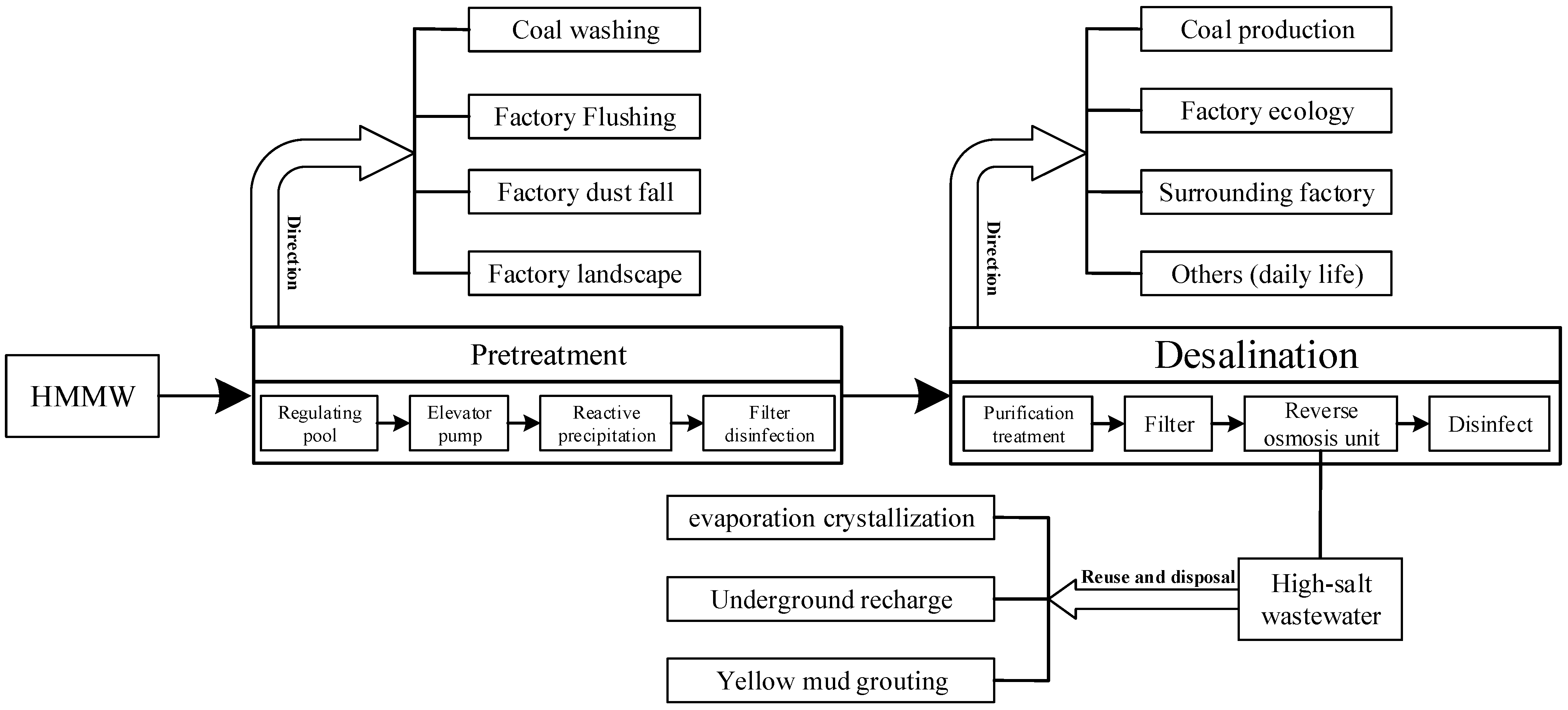

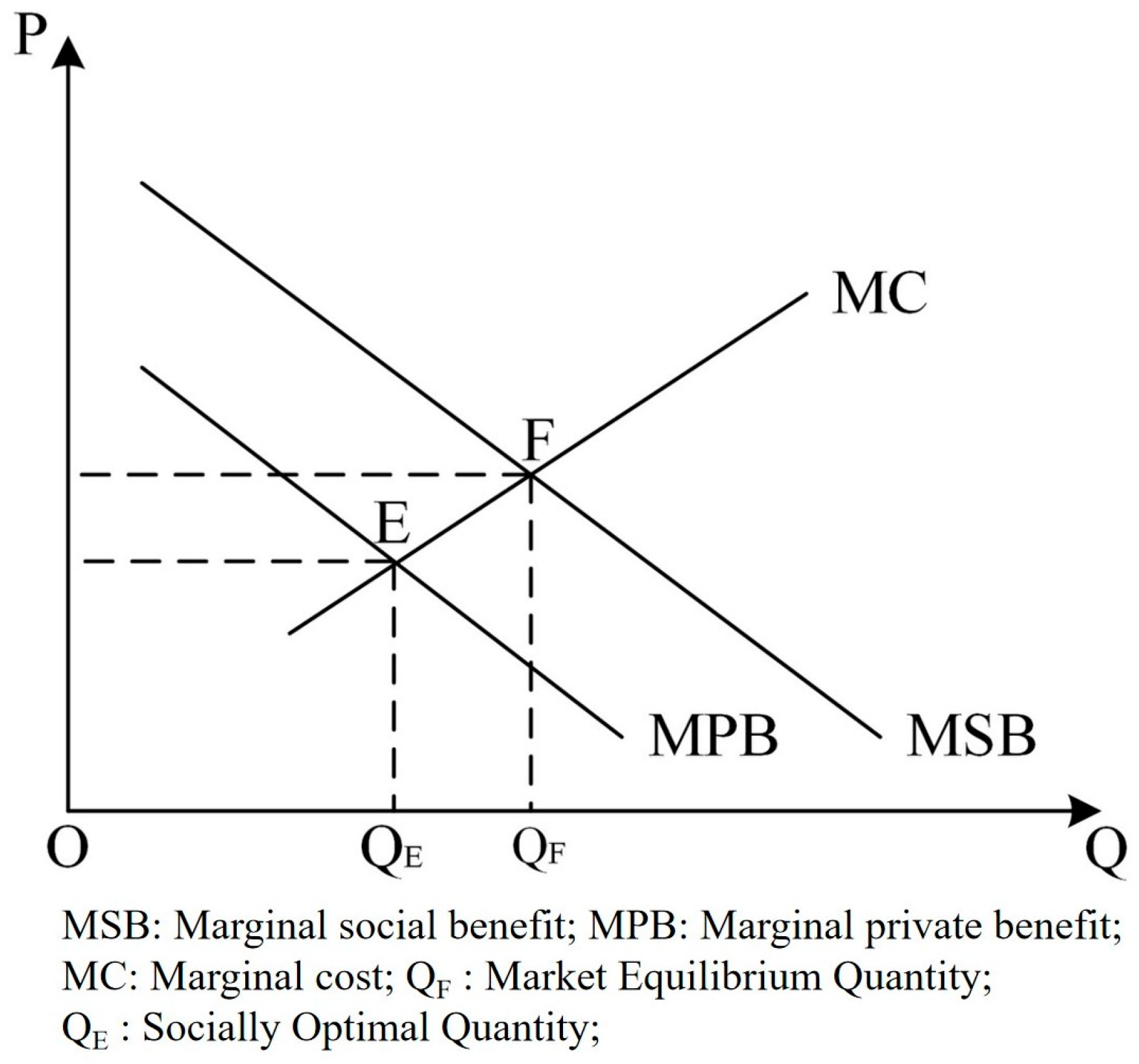
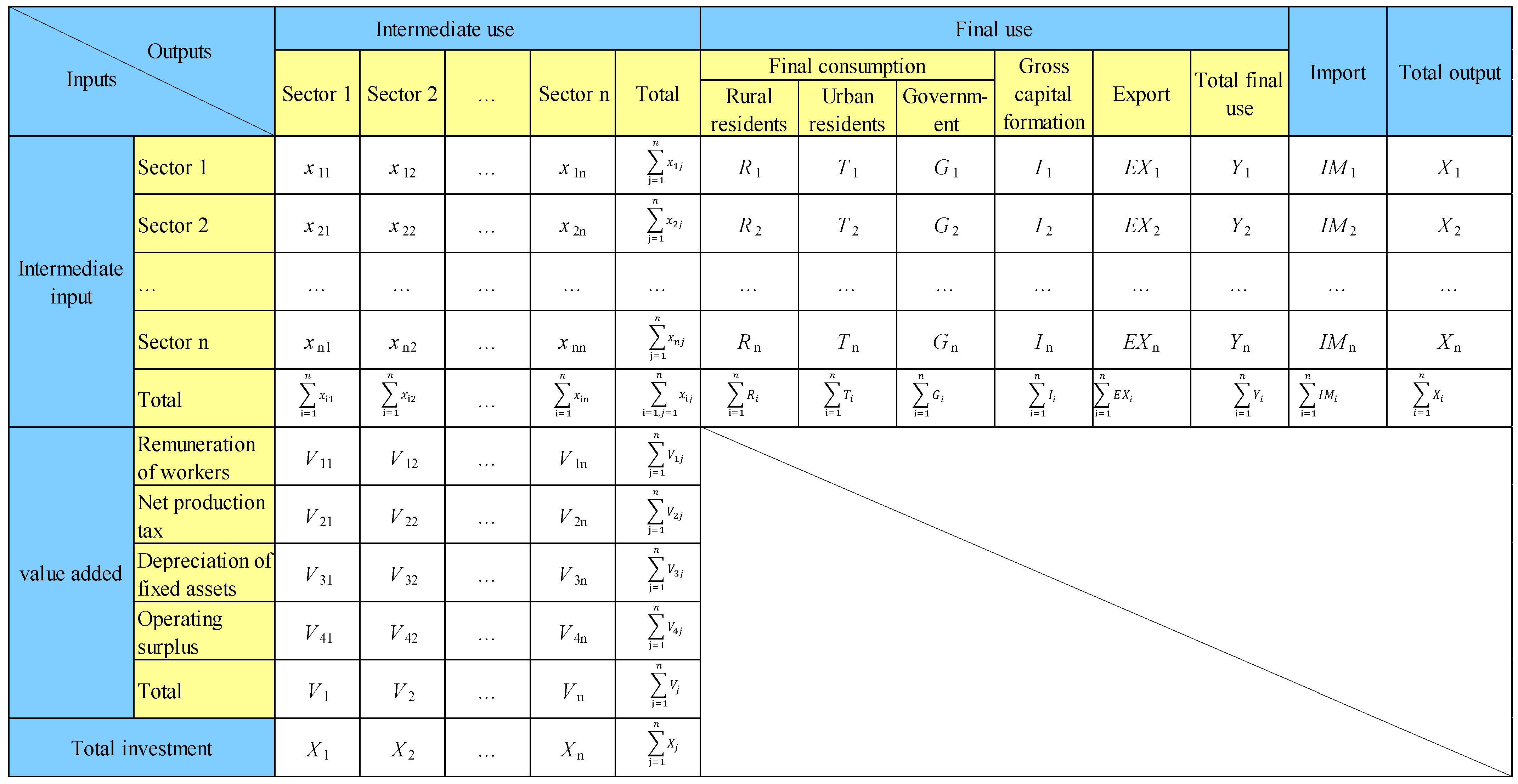
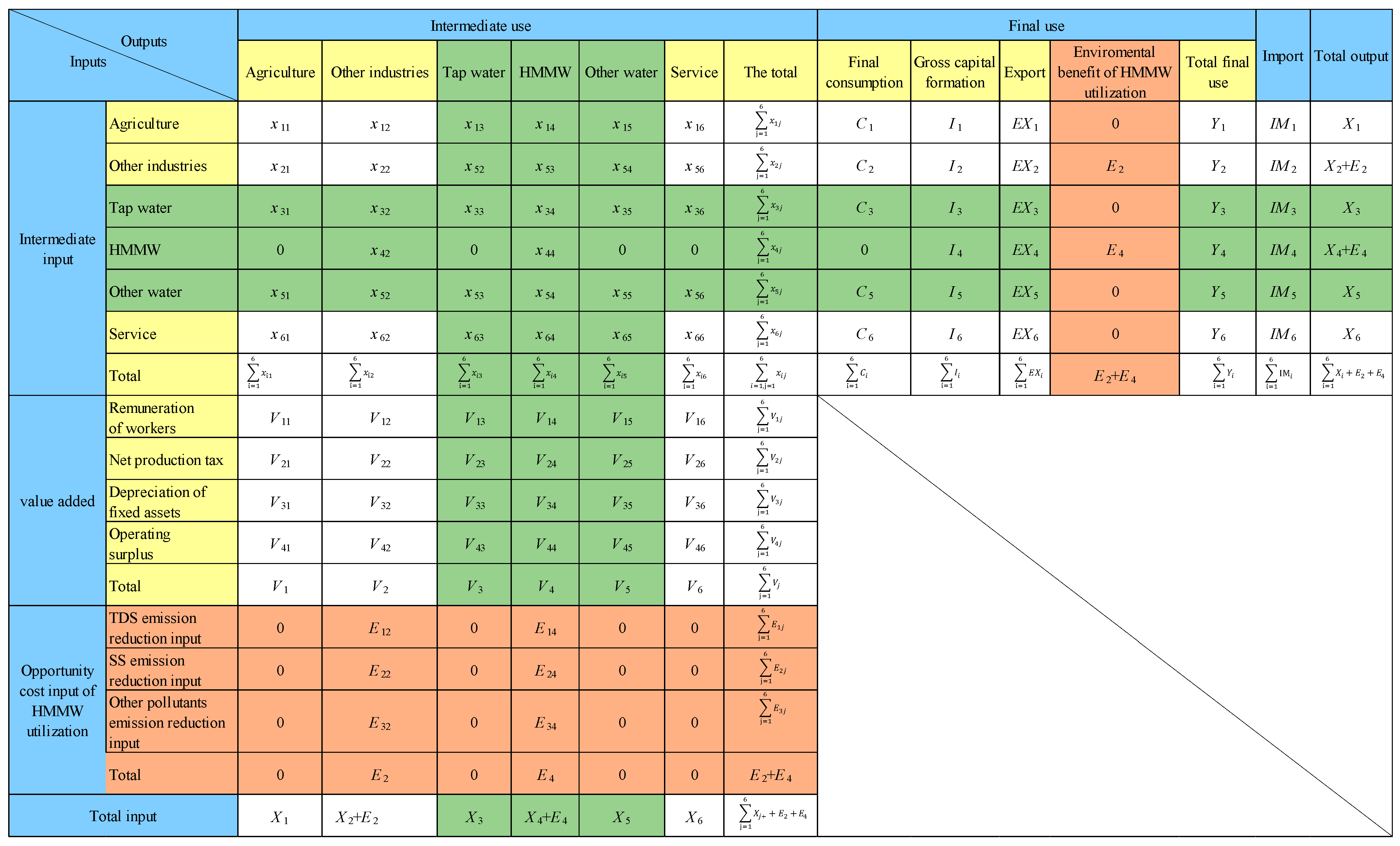
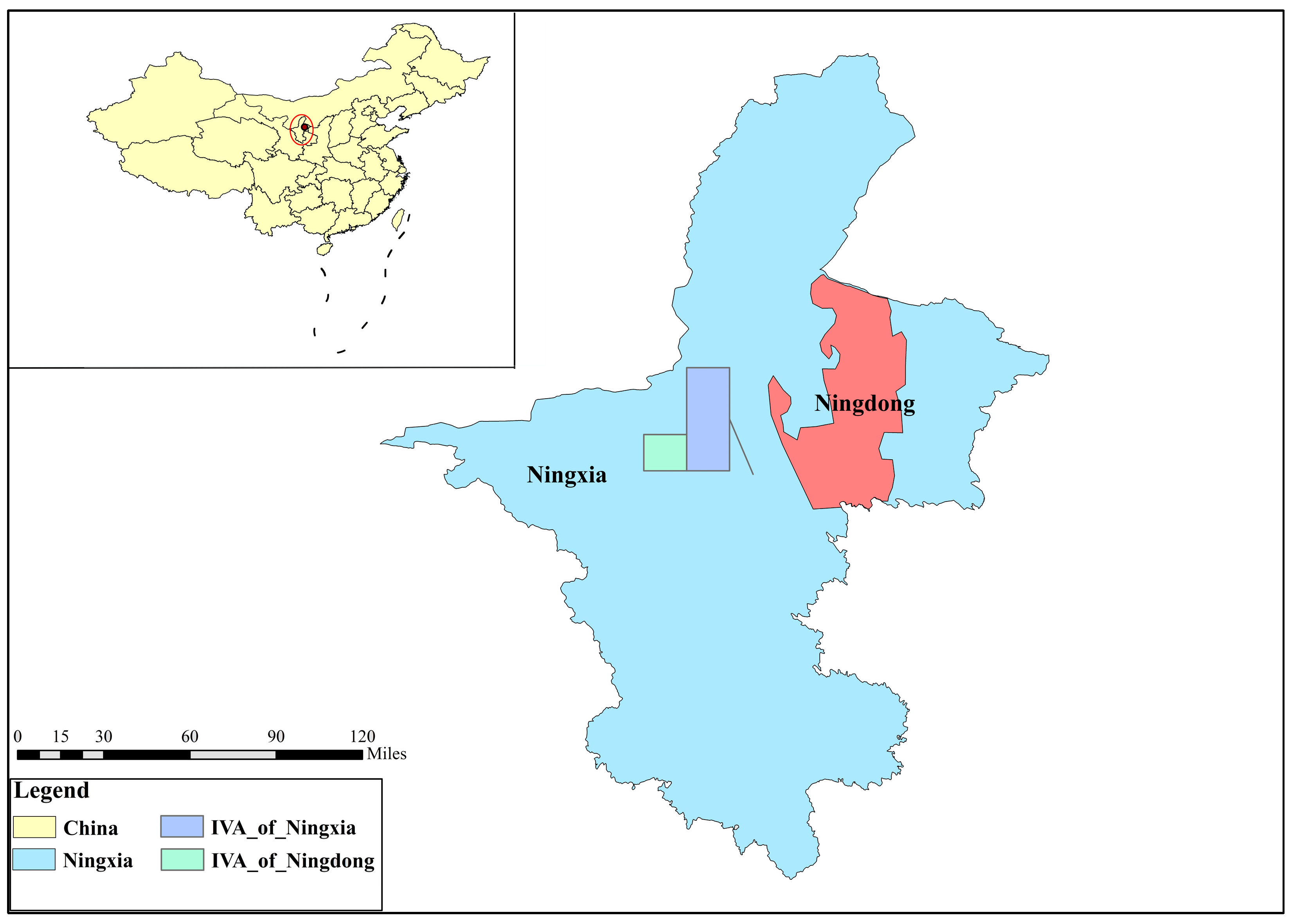
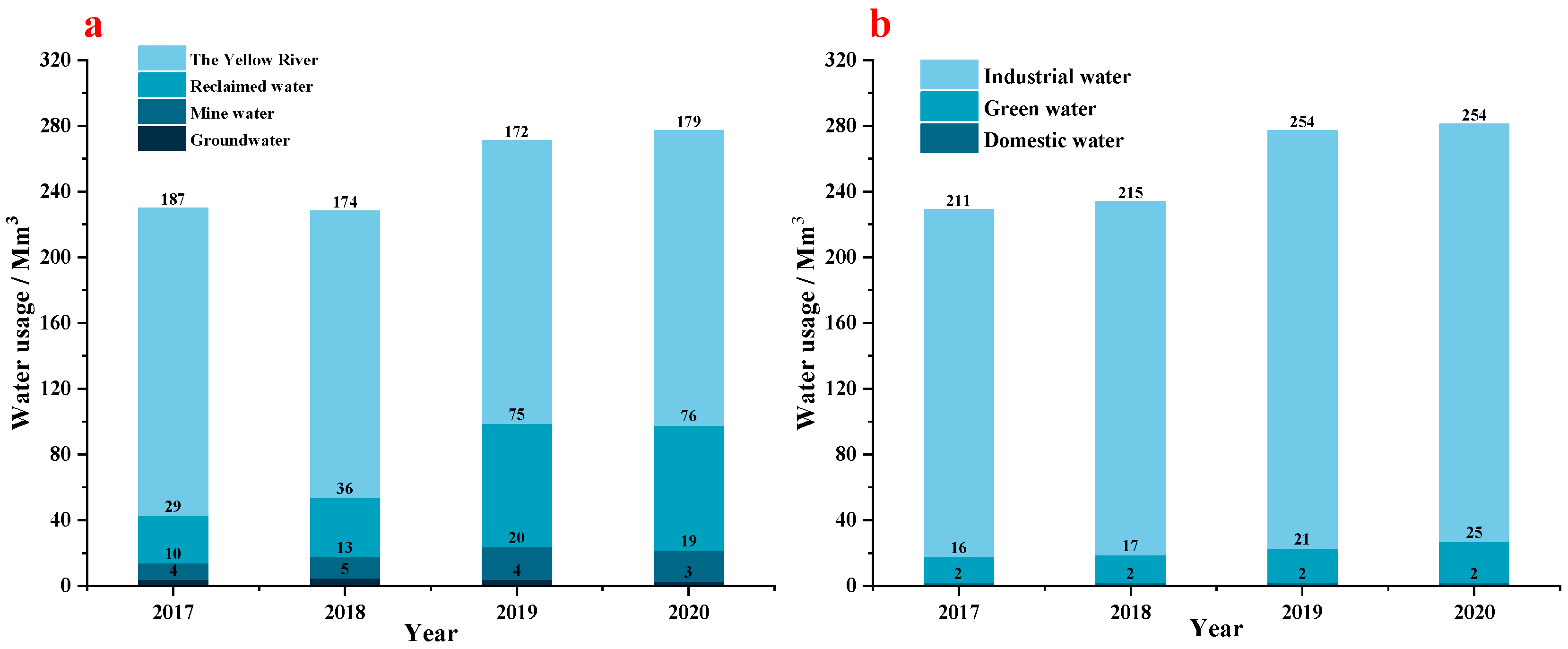
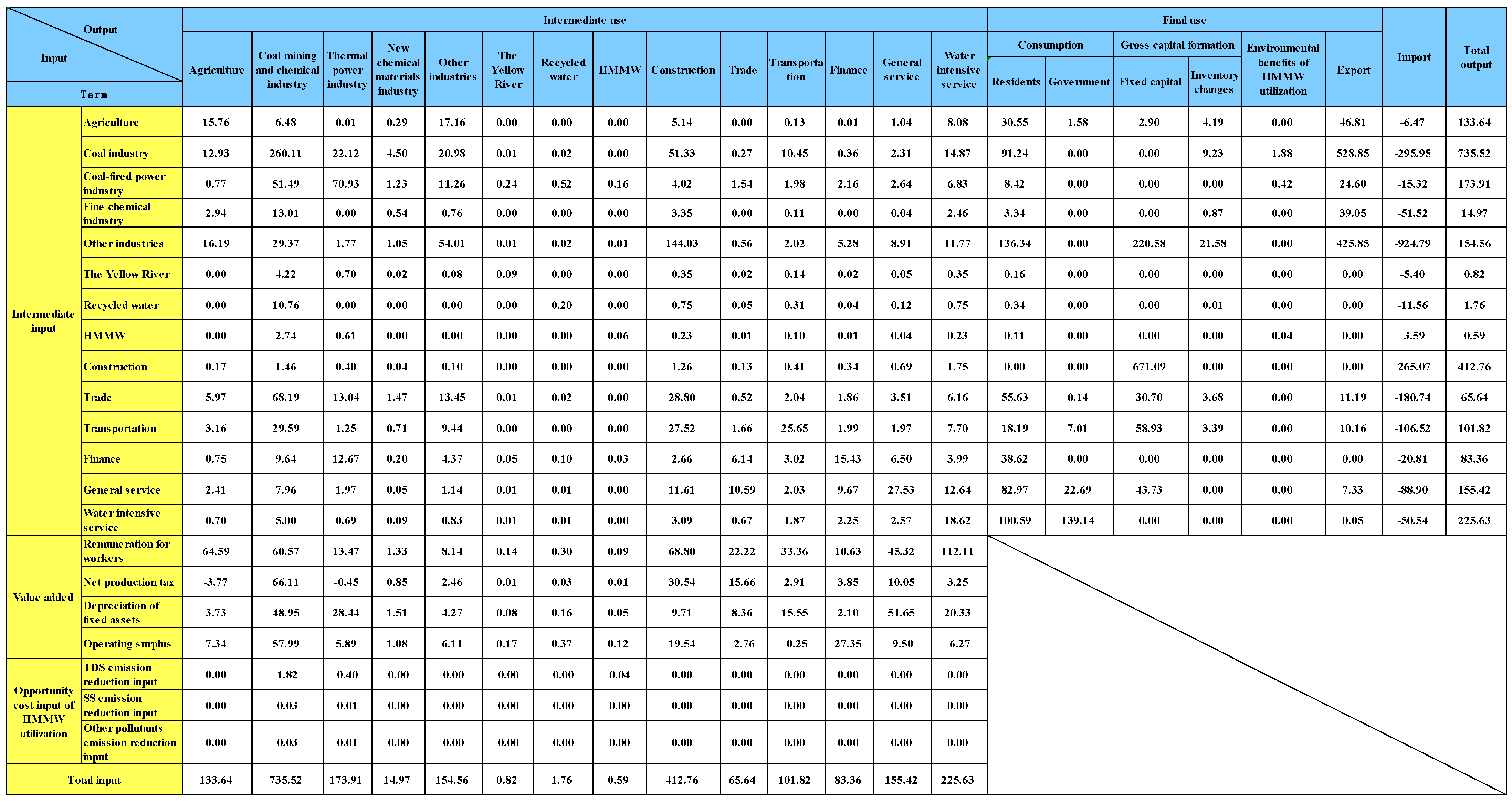
| Water Supply Project | Water Supply Project | Water Price |
|---|---|---|
| Ningdong water supply project | Industrial water | 2.8 |
| Domestic water | 2.8 | |
| Greening water | 1.3 | |
| Changcheng water supply project | Industrial water | 2.8 |
| Sun Mountain water supply project | Industrial water | 3.5 |
| Domestic water | 7.0 |
| Sector Classification | Consolidated Sectors | Detailed Sector Composition |
|---|---|---|
| Primary Sector | Agriculture | Forestry, Agro-, Livestock and Fisheries |
| Secondary Sector | Coal industry | Coal mining products; Oil & gas extraction products; Metal ore mining products; Non-metallic and other ore mining products; Petroleum, coking products and processed nuclear fuel products; Chemical products; Gas production and supply |
| Coal-fired power industry | Production and supply of electricity and heat | |
| Fine chemical industry | Chemical products | |
| Other industries | Food and tobacco industry; Textiles; Textile, clothing, shoes, hats, leather and down and its products industry; Wood processing products and furniture; Paper printing and stationery and sporting goods; Non-metallic mineral products; Metal Smelting and Rolling Products; Metal Products; General Purpose Equipment; Specialized equipment; Transportation facilities; Electrical machinery and instruments; Telecommunications devices, computers and other electrical devices; Instrumentation; Other manufacturing products and waste scrap; Metal goods, machinery and equipment repair services; | |
| Water production and supply industry | Water production and supply industry | |
| Tertiary Sector | Building Industry | Building Industry |
| Deal | Retail & Wholesale | |
| Transportation | Transportation, warehousing and mail | |
| Finance | Finance; | |
| Common Services | Information transmission, software and IT business; Finance; Real Estate; Hydraulic, environmental and public infrastructure management; Renting and Commercial Services; Real estate; Research and test development; Comprehensive technical services | |
| Water intensive service | Household services, maintenance and other services; Education Healthcare and community Work; Culture, Physical Education and Recreation; Public Management, Social Security and Social Groups |
| Industry | Industrial Output Value | Industrial Added Value |
|---|---|---|
| Coal industry | 748.6 | 238.4 |
| Coal-fired power industry | 173.5 | 47.3 |
| Fine chemical industry | 14.6 | 2.6 |
| Other industries | 139.9 | 18.4 |
| Industry | Yellow River Water | Recycled Water | HMMW |
|---|---|---|---|
| Coal industry | 422.0 | 1076.1 | 188.0 |
| Coal-fired power industry | 69.6 | 0.00 | 41.6 |
| Fine chemical industry | 2.5 | 0.00 | 0.00 |
| Other industries | 8.5 | 0.00 | 0.00 |
| Term | TDS | SS | Other Pollutants | |
|---|---|---|---|---|
| COD | TP | |||
| Cost/CNY·kg−1 | 1.30 | 7.81 | 3.64 | 292.45 |
| Concentration/mg·L−1 | 7658.40 | 22.33 | 33.43 | 0.12 |
| Industry | Consumptionm m3 | Environmental Benefits/M CNY | ||||
|---|---|---|---|---|---|---|
| TDS | SS | COD | TP | Total | ||
| Coal industry | 18.25 | 181.91 | 3.18 | 2.22 | 0.64 | 187.95 |
| Coal-fired power industry | 4.04 | 40.27 | 0.71 | 0.49 | 0.14 | 41.61 |
| HMMW industry | 0.40 | 3.99 | 0.07 | 0.05 | 0.01 | 4.12 |
| Total | 22.69 | 226.17 | 3.96 | 2.76 | 0.80 | 233.69 |
Disclaimer/Publisher’s Note: The statements, opinions and data contained in all publications are solely those of the individual author(s) and contributor(s) and not of MDPI and/or the editor(s). MDPI and/or the editor(s) disclaim responsibility for any injury to people or property resulting from any ideas, methods, instructions or products referred to in the content. |
© 2025 by the authors. Licensee MDPI, Basel, Switzerland. This article is an open access article distributed under the terms and conditions of the Creative Commons Attribution (CC BY) license (https://creativecommons.org/licenses/by/4.0/).
Share and Cite
Ma, C.; Lu, J.; Ni, H.; Zhong, Z.; Wang, H. An Environmental–Economic Benefit for Sustainability Assessment of Highly Mineralized Mine Water Reuse. Sustainability 2025, 17, 8965. https://doi.org/10.3390/su17198965
Ma C, Lu J, Ni H, Zhong Z, Wang H. An Environmental–Economic Benefit for Sustainability Assessment of Highly Mineralized Mine Water Reuse. Sustainability. 2025; 17(19):8965. https://doi.org/10.3390/su17198965
Chicago/Turabian StyleMa, Chaomeng, Jinzhi Lu, Hongzhen Ni, Zhencheng Zhong, and Haitang Wang. 2025. "An Environmental–Economic Benefit for Sustainability Assessment of Highly Mineralized Mine Water Reuse" Sustainability 17, no. 19: 8965. https://doi.org/10.3390/su17198965
APA StyleMa, C., Lu, J., Ni, H., Zhong, Z., & Wang, H. (2025). An Environmental–Economic Benefit for Sustainability Assessment of Highly Mineralized Mine Water Reuse. Sustainability, 17(19), 8965. https://doi.org/10.3390/su17198965






